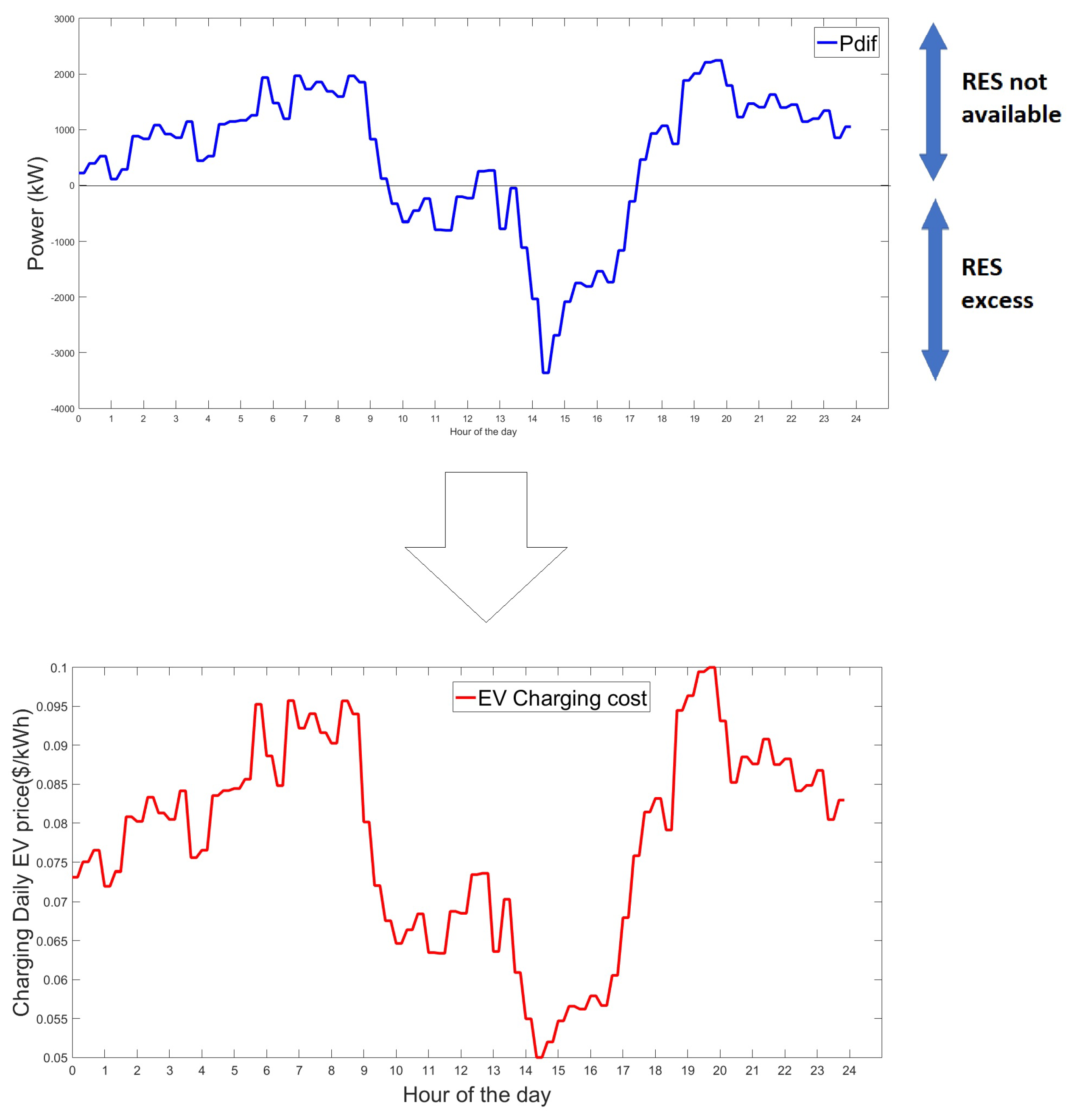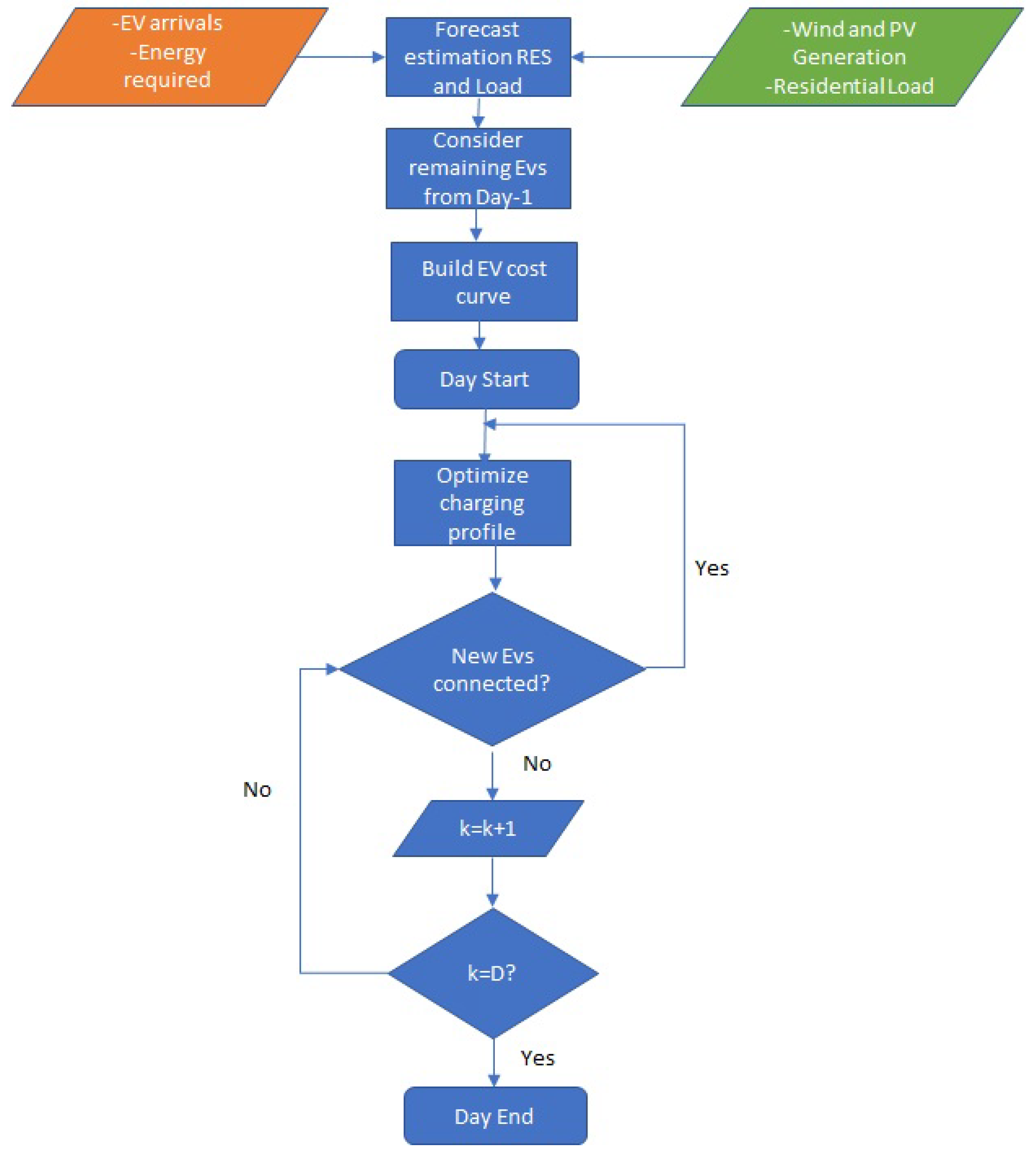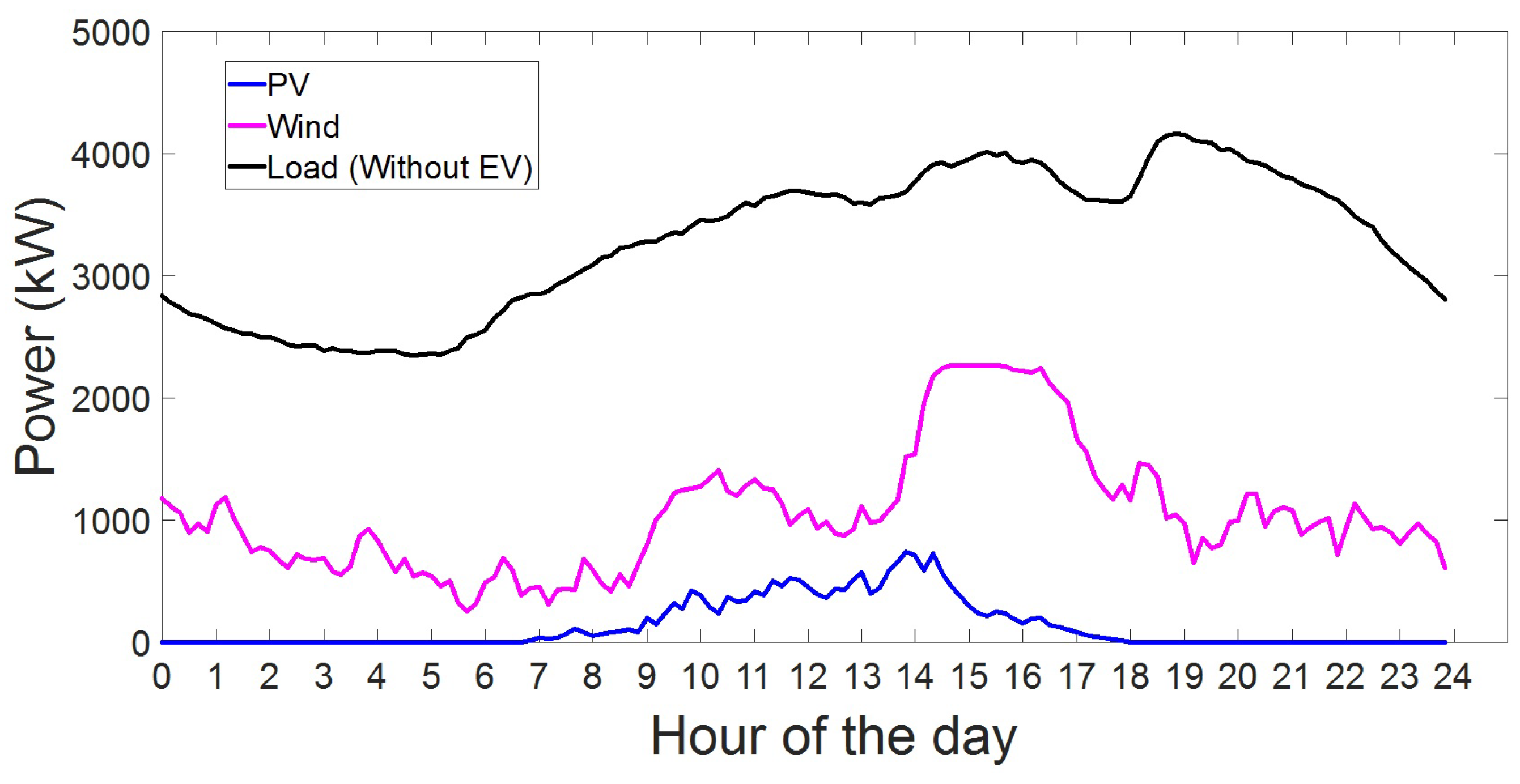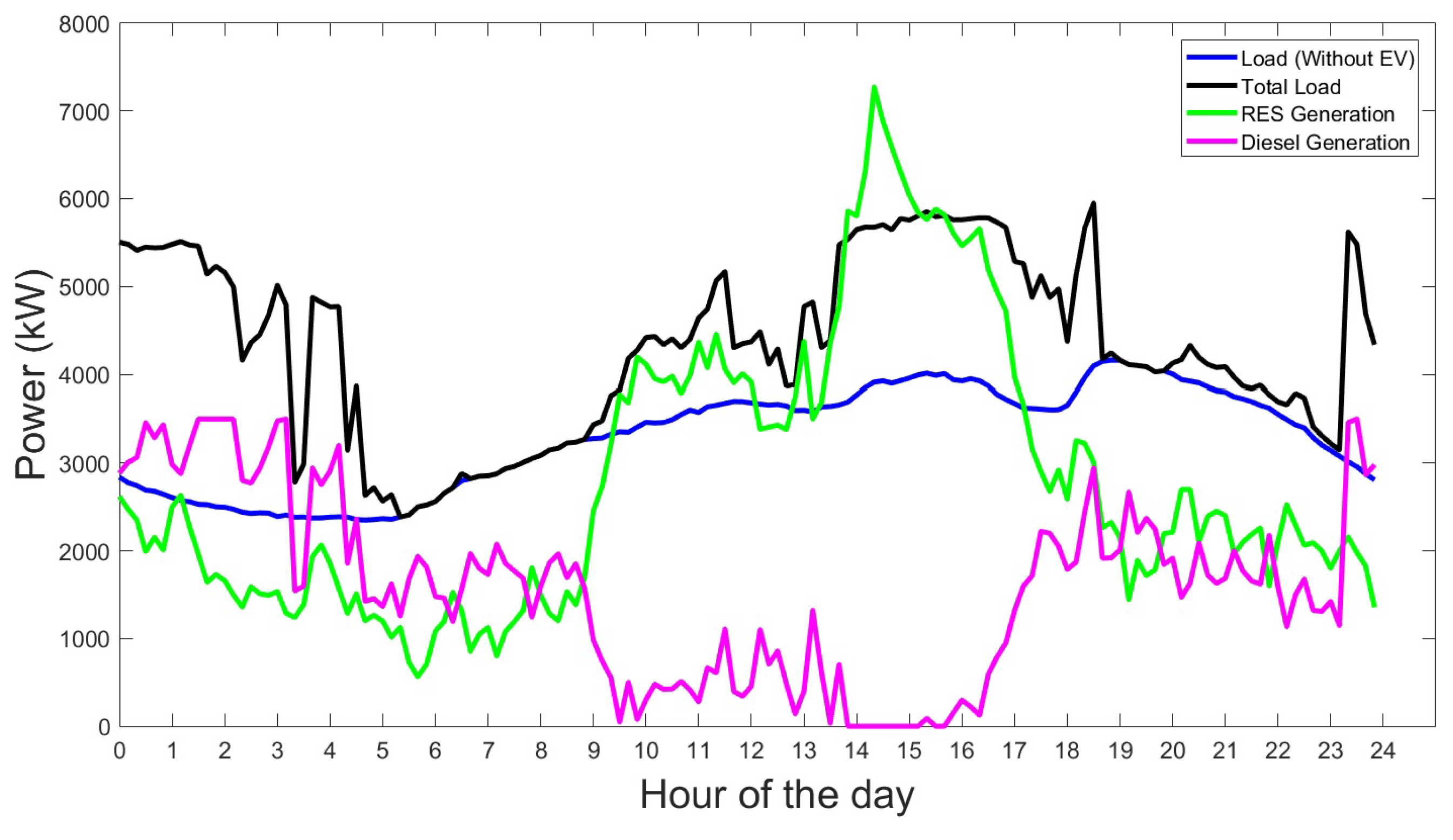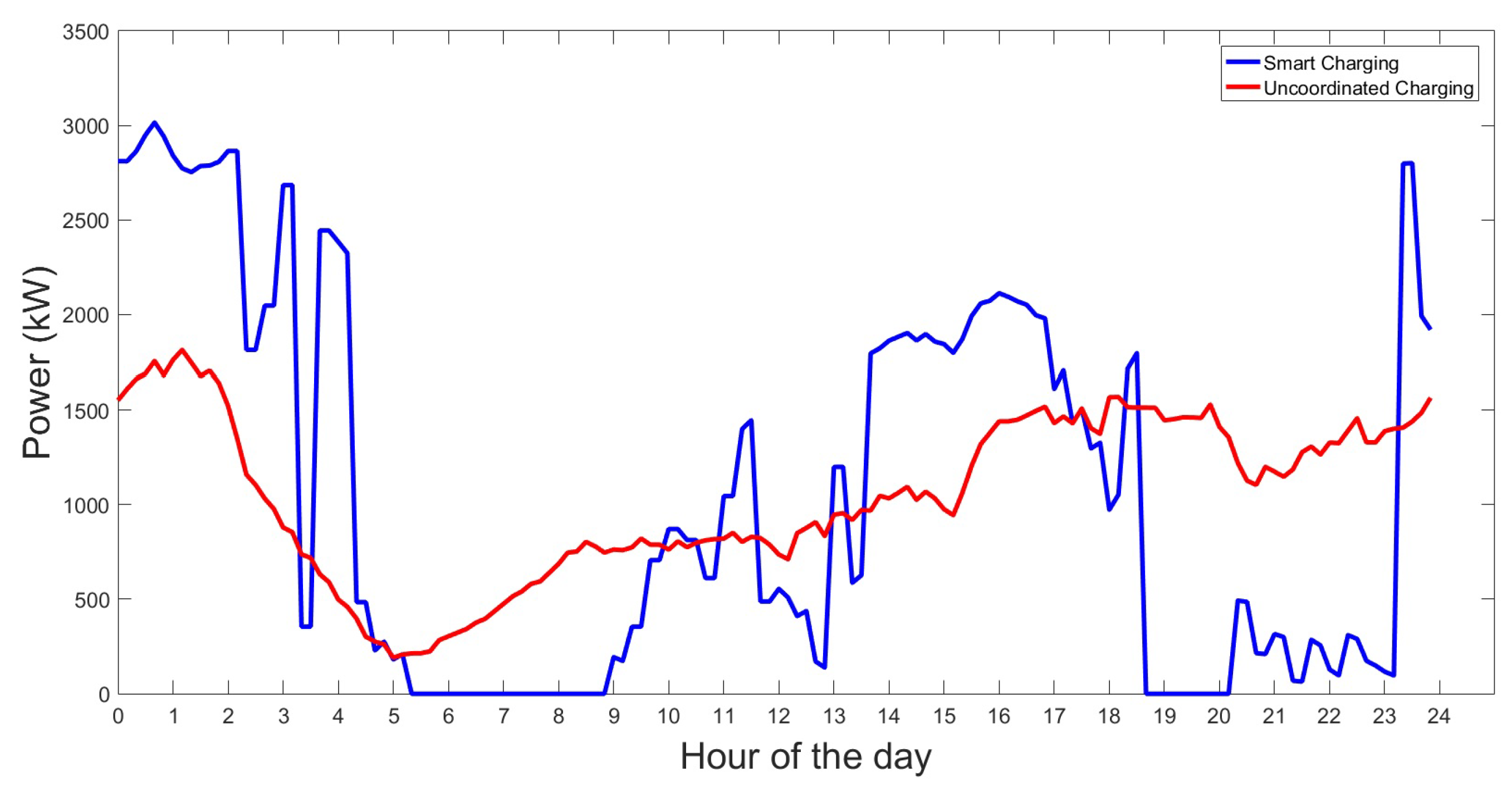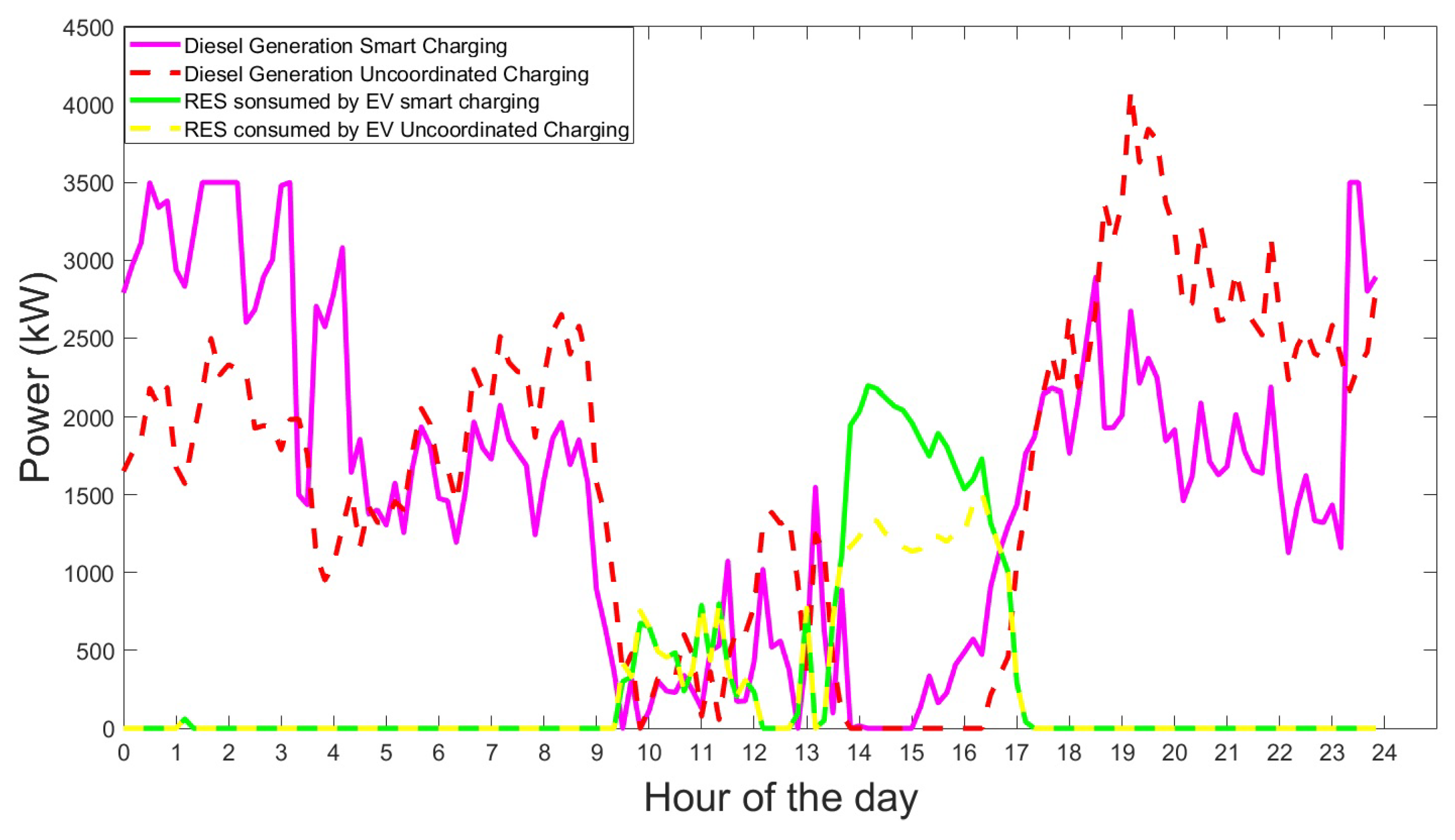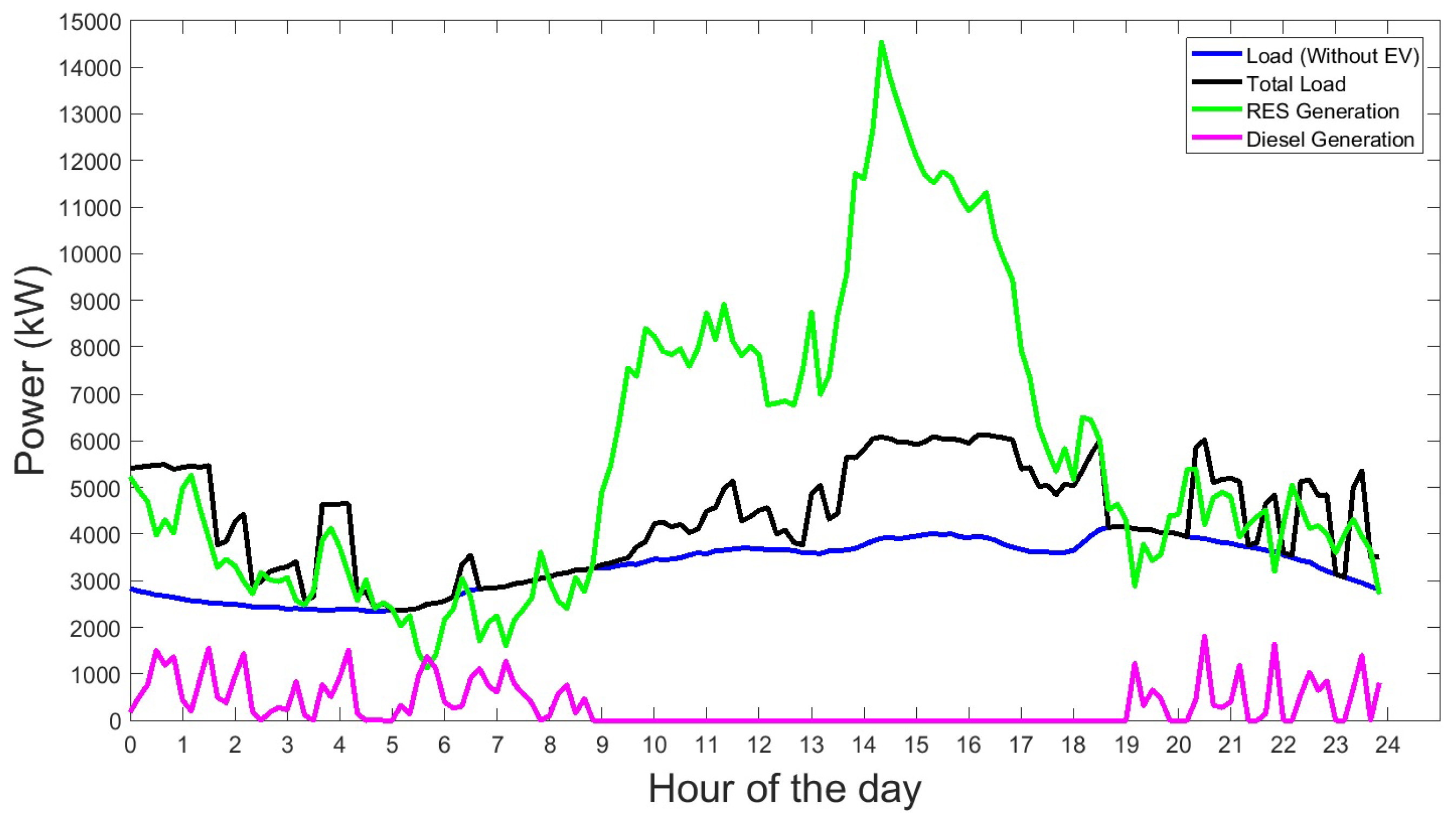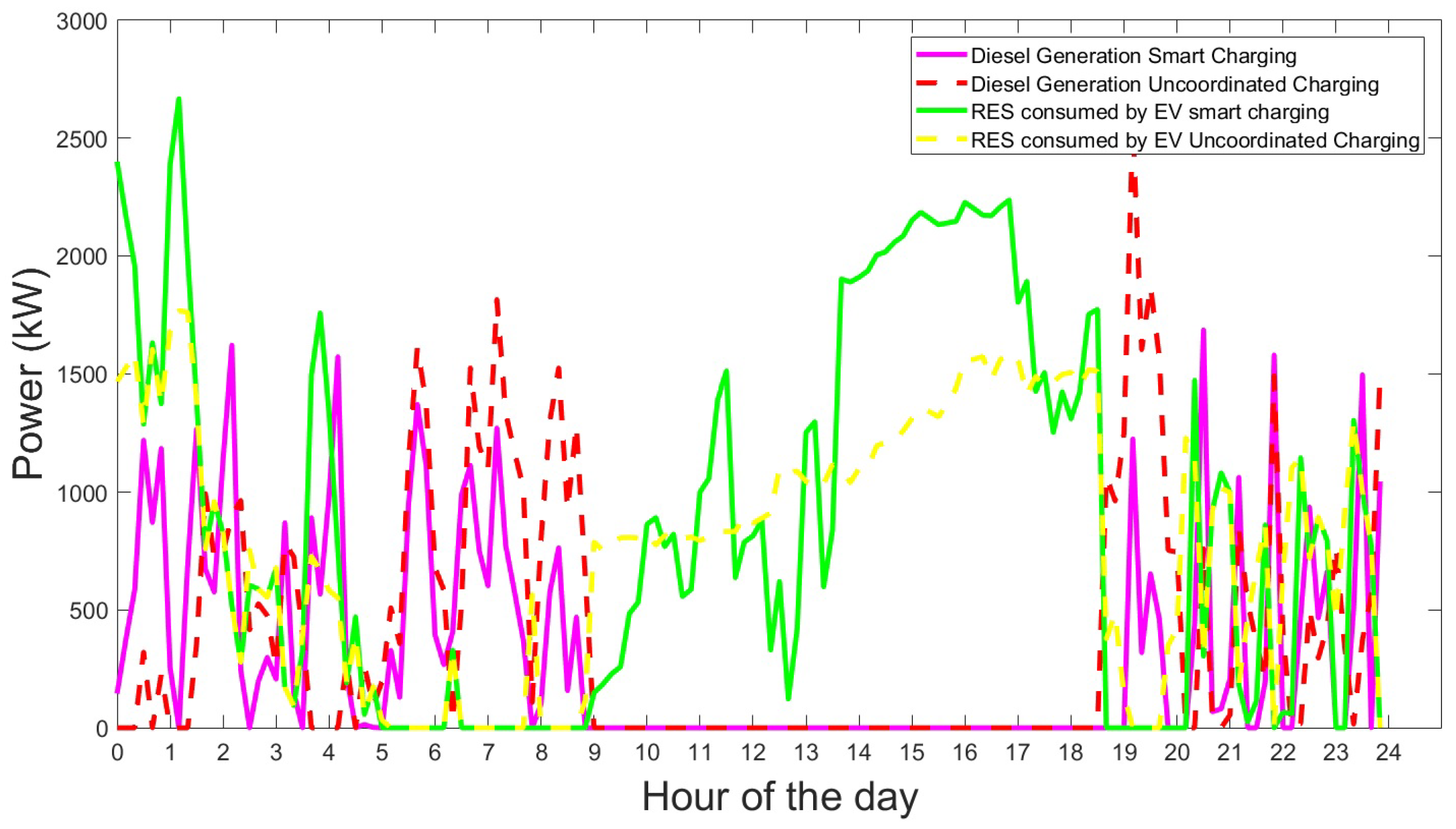1. Introduction
Climate change has pushed governments to create new energy policies. In particular, the energy activities that emit the highest amounts of greenhouse gases, such as CO
, are electricity generation and transportation [
1].
Hence, Renewable Energy Sources (RESs) emerge as new solutions to address this issue. They are naturally replenished sources that do not pollute locally and have a very low carbon footprint. The primary energy of these sources is transformed into secondary energy, such as electricity. However, some of the more critical problems of the use of RES in this area are the generation uncertainties and their high installation cost [
2,
3].
Various measures have been taken in several countries [
4] to achieve the target of CO
decrease. One of these measures consists of taxing CO
emissions to increase renewable energy production.
On the other side, Electric vehicles (EVs) seem to be a proper solution to reduce emissions in transportation. This generates zero emissions while driving, and electricity production causes its only footprint. However, a massive introduction to the grid could create negative impacts [
5,
6,
7,
8], and create new challenges for the power systems [
9,
10]. In particular, a massive introduction of EVs in distribution networks that have a high penetration of renewable electricity generation is even more complicated because of some issues, such as impacts on the performance of parking lot operators [
11], power systems security [
12], and planning of RES Sources [
13]. Thus, in recent years, some researchers have studied solutions for mitigating the adverse effects of EVs and also for creating new opportunities for the grid.
The objectives of the works of EV integration in RES systems include: charging parking lots management [
14,
15,
16], unit commitment models for EV integration [
12], microgrids’ energy management [
17,
18], EV charging facilities as energy micro hubs [
19], and the allocation of RES and EV charging stations [
20]. Fewer works have considered the operation of isolated grid systems considering EV loads. In particular, isolated microgrids ought to keep the system voltage and frequency within satisfactory ranges, but they can suffer significant variations from nominal operating conditions because of the variations in the power output of solar and wind sources [
21,
22].
In some places in the world, it is essential to change network conditions because of environmental situations, and the introduction of green sources are compulsory, such as the Galapagos Islands. They are an archipelago of volcanic islands. Therefore, Galapagos is a protected area: the previous Ecuadorean government has implemented some policies to protect them, especially because of the growth of population and tourism. Moreover, electricity generation is mainly based on diesel fuel, which results in significant environmental problems, and the transportation of fuels to the islands creates another concern due to the risk of possible spills. Therefore, the government of Ecuador decided to create the Program “Cero Combustibles Fósiles”, which consists of reducing gradually the fuel consumption in the islands [
23]. In that way, the government of Ecuador installed RES generation in the islands, such as solar and wind, as part of the policies for changing the matrix of electricity [
24]. The government also has the initiative of introducing EVs to replace internal combustion because of the environmental conditions mentioned above [
25], but this replacement does not include only traditional cars to electric ones, but also motorcycles and buses. As far as the present authors know, no work has been that studies the impact of different types of EVs in the grid operation. Hence, a methodology has to be implemented to avoid grid problems from this new load.
The aim of this paper is to propose an EV charging strategy in isolated distribution systems, such as Off-grid Microgrids, based on the optimization of the charging process and subject to the grid constraints. Furthermore, the methodology gives rise to increasing the use of available RES and resulting in a future increase of renewable energy production and reduction of CO
emissions. A case study of the Galapagos Islands is presented. This paper is an extension of an previous conference [
26], which has been significantly polished. The original contributions of the proposed methodology are highlighted as follows:
A strategy for EV charging in isolated electricity networks is proposed, considering a high presence of both wind and solar generation.
The EV aggregator optimizes the EV charging profile, through charging power rate modulation, while respecting actual grid conditions, using renewable power excess that is not consumed by other loads, and mitigating the RES power variations.
The methodology has to consider the participation of a different kind of EVs such as electric cars, motorcycles, and buses. Thus, the different energy requirements will be taken into account.
This paper is structured as follows: in
Section 2, the related works are presented. The methodology is described in
Section 3. The case study is discussed in
Section 4. The results are presented in
Section 5. Finally,
Section 6 highlights the conclusions.
3. Methodology
Several policies have been created for protected areas to reduce CO emissions related to the increase of both installed capacity of RES and EV penetration. However, System Operator (SO) may suffer from operating problems if there is not both a proper management system of RES and an EV smart charging plan.
To address this issue, a smart charging strategy is presented. Thus, when EV users plug their EV into the grid, they will allow EV aggregator modulating the power demanded during the EV charging process, through intelligent chargers and smart meters, which are assumed to be installed. Furthermore, it is assumed that a robust communication exists between the EVs and the EV aggregator, such as the one presented in [
44], and secure data communication, as per [
45]. The EV aggregator will manage all the EVs of the islands and it will communicate with the SO to develop a smart charging process that will respect grid constraints and reduce users’ costs. The EV aggregator will be only in charge of managing the EVs charge while the SO will be in charge of the operation of renewable generation. It could be also considered that the EV aggregator will be in interaction with residential customers’ aggregators, which will manage energy hubs as buildings [
46]. The EV aggregator will have to define a daily EV electricity cost curve when a new day starts, based on the forecasts. Then, it will have to optimize the charging of the EV fleet, based on this electricity curve and considering the needs of the EV users. The EV electricity cost, the problem formulation, and the EV charging methodology are detailed next. Observe that various known conditions are assumed to be known by the EV aggregator as input data. They could be predicted by estimation techniques such as presented in some papers discussed previously, but designing these forecasts are not the main focus of the paper.
3.1. EV Electricity Cost
EVs represent a new load, which has to be taken into account in the daily operation. If the RES penetration is higher than 30%, where inertia issues occur [
21], it could be advantageous to charge the EV when there is a high RES power available, which could result in excess of generation if the residential demand (excluding EVs) is too low. Moreover, if there is not enough RES power available and the residential load is high, it is crucial not to charge the EVs. Some work have already considered consuming this excess of RES energy such as [
47]. For this purpose, it might be beneficial to encourage this load consumption through the charging of the EV batteries by the EV aggregator, based on electricity pricing mechanisms. Hence, an electricity cost for EV users is proposed. The formulation considers proposing lower costs when RES power is in excess of maximizing its utilization and proposing higher costs when RES power is not available for minimizing electricity consumption from diesel. Note that this charging mechanism is only proposed for EV charging purposes, while the residential load (excluding EVs) has to respect its own tariff.
According to the characteristics of the pricing conditions of the case study, the daily specific electricity prices have to be between a minimum and maximum values and considering a mean value [
48]. For this purpose, a daily EV specific electricity cost for charging EVs is proposed to be between the minimum and maximum values,
and
, which have to be fixed by the EV aggregator. It is also assumed that the EV specific electricity cost has a daily mean
equal to the mean proposed by the Ecuadorean regulator for the residential load. These conditions could be changed depending on the local regulations.
For the calculation of the EV electricity cost, the difference of the residential load and RES generation
, including PV power
and Wind Power
, is considered, for each time interval
k in a day:
In a day, the negative values of
represent a RES power excess. If the value is 0, it means that RES power satisfies precisely the load. A positive value implies that there is not enough RES power to satisfy load demand and it is necessary to generate the remaining power by diesel generation. Therefore, it is considered that the charging mechanism for EV is built considering the trend of
during a day. As per [
49], pricing approaches have to be considered for the consumers, so the lower costs will be when there is an RES power excess (negative values) and the most expensive ones when the electricity has to be generated by diesel (positive values). For the case study, electricity prices have to be positive. In order to consider the trend of
, but with only positive values, a system of equations has to be solved.
A system of three equations with three unknown variables {a,b,c} has to be solved by the system in order that the specific electricity cost curve follows the trend of
curve:
This system has to be solved by the EV aggregator with the forecast values before the beginning of the new day. It is assumed that the forecast predictions are very reliable.
After obtaining the variables, the specific cost
is obtained:
Let’s suppose that
P,
P and
P are the vectors of decision variables for the charging power of cars, motorcycles, and buses, which are defined based on the number of owners they have:
The total load demanded from EV charging at interval
k is defined as the sum of the demand of the cars, motorcycles, and buses:
The total energy needed for charging all the EVs in a day (kWh) is defined:
EV Daily costs correspond to the sum of all the costs of the charge process of all the EV types, for all the time intervals
k in a day:
The specific cost is obtained by changing the scale of the curve of
and adapting to a new interval, as represented in
Figure 1.
3.2. Problem Formulation
The model maximizes the RES energy excess consumed by EVs and minimizes the electricity production from diesel, based on the charging of EVs:
Moreover, the problem is equivalent of minimizing the daily cost of the EV charging:
The problem is subject to the following constraints:
Supply-demand balance in the microgrid
The EV load has not to overpass the maximum grid capacity. It means that the sum of all the demand, including EV and residential loads, and the losses might be lower than the power balance of all the generation production, including solar, wind and diesel, for each time interval
k, expressed as:
Maximum EV Charging Power Rate
The EV aggregator has to modulate the EV charging power rate between zero and the upper bound, which corresponds to the maximum charging power that the charger from each kind of EV
e allows:
Daily EV user energy required
At the beginning of the charging, each EV user
i specifies the energy needed the EV aggregator has to respect:
In this methodology, minimum and maximum power constraints of generators are not taken into account because only a small part of this power is considered to be demanded by EV charging so that the other electric loads will demand the rest of power. Transmission network constraints were not considered either because the grid is mainly composed of only a generation and distribution system.
The problem can be solved by a linear optimization for each EV.
3.3. EV Charging Mechanism
At the end of Day 1, the system operator processes the data of RES Generation and Load Demand from all the day.
After processing the data, and including the EV charging that was not completed the day before, the system operator has to create the specific electricity cost curve.
Real-time information of the new cars plugged is sent to the EV aggregator each time interval, which could be performed by smart meters installed in the customer facility. If new cars are connected to the grid, the smart meter linked to them will have to send the information about the charging, such as the energy required by the EV user.
Then, the cost optimization has to be performed, which will be carried out through the charging power rate modulation between zero and the maximum EV charging power rate . The time in which the EV charging ends will also be known. The optimization process will determine the new charging rate according to both the network constraints and the committed charging previously.
EV aggregator will inform each time interval of the EV load to the SO to produce the required diesel generation.
The flowchart of the methodology is illustrated in
Figure 2.
5. Results and Discussion
5.1. Scenarios Definition
As previously mentioned, the newly installed capacity of the RES generation in Santa Cruz is uncertain. Thus, to assess the influence of the methodology for different capacities of both wind and PV, nine scenarios are studied, which combine different installed capacities of PV (5, 7.5 and 10 MW) and Wind (5, 7.5 and 10 MW). All the scenarios are resumed in
Table 2, depending on the assumed installed capacity of wind and solar. The present conditions are not taken into account because of the actual low RES penetration.
Firstly , to evaluate the daily operation, the simulations of the smart charging methodology are compared to a case of uncoordinated charging, which consists of EV users starting their charging at a maximum charging power rate immediately after they are plugged to the grid. For this evaluation, two scenarios are selected with very different installed capacity, which correspond to the first scenario (5 MW of PV and 5MW of Wind), and the ninth scenario (10 MW of PV and 10 MW of Wind). The analysis of daily operations is performed.
Then, all the costs of the nine scenarios are studied to show the importance of proper management of EV charging when there is a high presence of renewable electricity generation in the grid. These scenarios are studied for several months from the data available from [
13,
26].
5.2. Daily Operation: Scenario 1
Scenario 1 corresponds to an installed capacity of 5 MW of Wind and 5 MW of PV. From the simulations of the proposed methodology, the charging patterns of the smart charging for all the EVS are represented in
Figure 4, and the load patterns of the different types of EVs are compared.
The energy required for charging electric motorcycles is very small compared with the energy for the other kind of EVs. Buses are the EVs that consume the most energy, especially during the night, when the RES power is not significantly available.
Figure 5 represents the different loads and the generation output. The EV Load is able to absorb a large part of the RES energy, particularly during the day. Moreover, from 10:00 a.m. until 4:00 p.m., diesel generation is minimal.
In
Figure 6, the patterns for both Smart and Uncoordinated Charging are shown. Significant peaks and valley periods occur in the Smart Charging pattern corresponding to the absence or surplus of energy from RES.
The excess power from RES is expressed:
The daily excess energy from RES is expressed:
The excess power from RES consumed by EV is expressed:
The excess energy from RES consumed by EVs is expressed:
Figure 7 presents the electricity that has to be produced by Diesel generators and the RES energy excess consumed by EVs.
It was observed that, with the smart charging, the EVs consume more RES energy and less diesel energy. Note also that the RES energy excess is not very significant.
Table 3 summarizes the energy consumed, total costs and specific costs both for uncoordinated and smart charging for each type of EV. Smart Charging results in lower costs than Uncoordinated Charging for all types of EVs. The most critical difference is for electric cars for which the Specific Cost has a difference of 9.9% between uncoordinated and smart charging. The difference for all the EV charging between uncoordinated and smart is 7.9%.
The ratio of RES energy excess consumed and EV
is expressed as:
This relation demonstrates the RES excess energy that is consumed by EVs overall energy that was supplied for EV charging.
Table 4 shows the total amount of Electricity generated by Diesel and the RES energy excess that is consumed in charging EVs.
As can be seen, the Smart Charging of EVs involves 4.6% less electricity produced by Diesel and 23.9% more consumption of RES energy excess compared to uncoordinated charging. Furthermore, the ratio of RES energy excess used for charging EV is 31.8% more significant for Smart Charging than for Uncoordinated Charging. Note that the values of the ratios for the two kinds of charging are relatively significant.
5.3. Scenario 9: Daily Operation
This scenario increased the same proportions of PV and Wind Generation, with an installed power capacity of 10 MW capacity for both PV and Wind. The different patterns from generation and loads are represented in
Figure 8. The EV charging load is quite similar to that of Scenario 1, but as the RES capacity is higher, RES energy excess that was not seen in reference scenario is available at specific periods of the night. It can be seen that EV charging absorbs RES power peaks. However, since the RES installed capacity is very high, there is a significant amount of RES energy that cannot be consumed.
In
Figure 9, the Diesel generation and RES energy excess consumed by EVs are represented both for smart and uncoordinated charging. As the RES power capacity increases, so do total Diesel generation and RES energy excess consumed by EV.
Table 5 shows the total amount of Electricity generated by Diesel and the RES energy excess consumed for charging EVs in Scenario 9. As in scenario 1, the costs and specific costs are lower with smart charging than with uncoordinated charging, but the total difference drops (7% for the specific cost) and the total costs and specific costs are more significant for smart charging between the reference scenario and scenario 2. This finding is because the cheaper periods of electricity cannot be used for charging EVs because there is no significant demand for charging at these periods.
Table 6 shows the total amount of electricity generated by Diesel and the RES excess energy that is consumed for charging EVs. The Smart Charging of EVs has 23.3% less electricity produced by Diesel and 8.6% more consumption of the RES energy excess compared to uncoordinated charging.
5.4. Medium-Term Operation
RES generation presents fluctuations from one day to other, so different scenarios are evaluated from the data available from July to November 2015, to evaluate the methodology in a longer period.
The results of the different parameters studied are represented in
Table 7. It is observed that the costs
C are very similar in all cases, but they are relatively lower with a high presence of wind generation. In particular, EV load corresponds more to periods when wind generation is high. Note also that the excess of energy consumed by EVs presents fair values for the Scenario 6, which corresponds to an installed capacity of 7.5 MW of both Wind and PV. The first scenarios result in low values of
and the last scenarios in relatively high values of
, but considering high RES installed capacity.
5.5. Discussion
It was demonstrated that the excess of RES power, which results from the unbalance between the load and generation could be adequately managed by charging the EVs. However, the installed capacity of RES has to be appropriately planned because the EV load can not only consume a very high amount of excess of RES power. Furthermore, for implementing the methodology, it has to be considered the additional installation of local microgrid controllers, in order to avoid stability issues due to the variability of the RES power.
However, this methodology presents several advantages and can be appropriately integrated into similar microgrid systems.
6. Conclusions
An EV charging strategy was studied in this work to encourage RES integration in isolated distribution systems, such as Off-grid Microgrids. The smart charging methodology for EV considered the RES power availability, through cost optimization, which is based on EV charging power modulation. This charging mechanism was simulated in Santa Cruz, which is a protected island of Galapagos and works in off-grid mode. Different kinds of EVs that could be introduced in the Galapagos Islands were considered in the methodology in the charging process.
The EV charging strategy was compared to cases of Uncoordinated Charging. It was observed that the EV aggregator could reduce costs: 7.9% for a case of 5 MW installed capacity (wind and PV each), 7% for a case of 10 MW installed (wind and PV each). In addition, it is observed an increase in the use of RES excess energy by EV load, as well as a decrease of the Diesel generation, while respecting grid conditions. Moreover, this will lead to a significant decrease of CO
emissions, which could reach up to 12,780 kg/day avoided in Scenario 9 [
13], and thus mitigate contamination in the island.
Nine scenarios from different installed capacities of wind and PV were studied, where two scenarios were illustrated for daily charging. The costs of the nine scenarios were evaluated in the medium term. The increase of the RES installed capacity holds the EV aggregator specific costs almost equal but leads to a decrease of the Diesel use and in an increase of the RES excess energy consumed by EV.
The main limitation of this work lies in the significant amount of RES excess energy that cannot be absorbed by EV with high RES capacity installation. In fact, EVs play a key role in the new power systems, but they are not the only factor; for a better RES integration, it is necessary to complement with residential load management strategies such as demand response and integration of energy storage.
